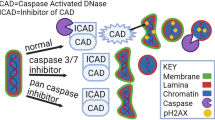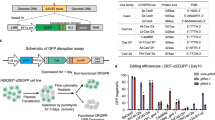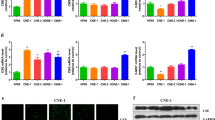Abstract
As a critical apoptosis executioner, caspase-3 becomes activated and then enters into the nucleus to exert its function. However, the molecular mechanism of this nuclear entry of active caspase-3 is still unknown. In this study, we revealed that caspase-3 harbors a crm-1-independent nuclear export signal (NES) in its small subunit. Using reverse-caspase-3 as the study model, we found that the function of the NES in caspase-3 was not disturbed by the conformational changes during induced caspase-3 activation. Mutations disrupting the cleavage activity or p3-recognition site resulted in a defect in the nuclear entry of active caspase-3. We provide evidence that the p3-mediated specific cleavage activity of active caspase-3 abrogated the function of the NES. In conclusion, our results demonstrate that during caspase-3 activation, NES is constitutively present. p3-mediated specific cleavage activity abrogates the NES function in caspase-3, thus facilitating the nuclear entry of active caspase-3.
Similar content being viewed by others
Log in or create a free account to read this content
Gain free access to this article, as well as selected content from this journal and more on nature.com
or
Abbreviations
- rev-caspase-3:
-
(reverse-caspase-3)
- NES:
-
(nuclear export signal)
- NLS:
-
(nuclear localization signal)
- LMB:
-
(leptomycin B)
References
Marsden VS, Strasser A . Control of apoptosis in the immune system: Bcl-2, BH3-only proteins and more. Annu Rev Immunol 2003; 21:71–105.
Budihardjo I, Oliver H, Lutter M, Luo X, Wang X . Biochemical pathways of caspase activation during apoptosis. Annu Rev Cell Dev Biol 1999; 15:269–290.
Earnshaw WC, Martins LM, Kaufmann SH . Mammalian caspases: structure, activation, substrates, and functions during apoptosis. Annu Rev Biochem 1999; 68:383–424.
Kamada S, Kikkawa U, Tsujimoto Y, Hunter T . Nuclear translocation of caspase-3 is dependent on its proteolytic activation and recognition of a substrate-like protein(s). J Biol Chem 2005; 280:857–860.
Takemoto K, Nagai T, Miyawaki A, Miura M . Spatio-temporal activation of caspase revealed by indicator that is insensitive to environmental effects. J Cell Biol 2003; 160:235–243.
Fischer U, Janicke RU, Schulze-Osthoff K . Many cuts to ruin: a comprehensive update of caspase substrates. Cell Death Differ 2003; 10:76–100.
Sahara S, Aoto M, Eguchi Y, et al. Acinus is a caspase-3-activated protein required for apoptotic chromatin condensation. Nature 1999; 401:168–173.
Faleiro L, Lazebnik Y . Caspases disrupt the nuclear-cytoplasmic barrier. J Cell Biol 2000; 151:951–959.
Kamada S, Kikkawa U, Tsujimoto Y, Hunter T . A-kinase-anchoring protein 95 functions as a potential carrier for the nuclear translocation of active caspase-3 through an enzyme-substrate-like association. Mol Cell Biol 2005; 25:9469–9477.
Srinivasula SM, Ahmad M, MacFarlane M, et al. Generation of constitutively active recombinant caspases-3 and -6 by rearrangement of their subunits. J Biol Chem 1998; 273:10107–10111.
Henderson BR, Eleftheriou A . A comparison of the activity, sequence specificity, and CRM1-dependence of different nuclear export signals. Exp Cell Res 2000; 256:213–224.
Suzuki Y, Nakabayashi Y, Takahashi R . Ubiquitin-protein ligase activity of X-linked inhibitor of apoptosis protein promotes proteasomal degradation of caspase-3 and enhances its anti-apoptotic effect in Fas-induced cell death. Proc Natl Acad Sci USA 2001; 98:8662–8667.
Rotonda J, Nicholson DW, Fazil KM, et al. The three-dimensional structure of apopain/CPP32, a key mediator of apoptosis. Nat Struct Biol 1996; 3:619–625.
Wei Y, Fox T, Chambers SP, et al. The structures of caspases-1, -3, -7 and -8 reveal the basis for substrate and inhibitor selectivity. Chem Biol 2000; 7:423–432.
Chang NS, Doherty J, Ensign A . c-Jun N-terminal kinase 1 (JNK1) physically interacts with WW domain-containing oxidoreductase (WOX1) and inhibits WOX1-mediated apoptosis. J Biol Chem 2003; 278:9195–9202.
Lee JC, Schickling O, Stegh AH, et al. DEDD regulates degradation of intermediate filaments during apoptosis. J Cell Biol 2002; 158:1051–1066.
Garcia-Domingo D, Ramirez D, Gonzalez de Buitrago G, Martinez AC . Death inducer-obliterator 1 triggers apoptosis after nuclear translocation and caspase upregulation. Mol Cell Biol 2003; 23:3216–3225.
Morgan M, Thorburn J, Pandolfi PP, Thorburn A . Nuclear and cytoplasmic shuttling of TRADD induces apoptosis via different mechanisms. J Cell Biol 2002; 157:975–984.
Brown VM, Krynetski EY, Krynetskaia NF, et al. A novel CRM1-mediated nuclear export signal governs nuclear accumulation of glyceraldehyde-3-phosphate dehydrogenase following genotoxic stress. J Biol Chem 2004; 279:5984–5992.
Sen N, Hara MR, Kornberg MD, et al. Nitric oxide-induced nuclear GAPDH activates p300/CBP and mediates apoptosis. Nat Cell Biol 2008; 10:866–873.
Ura S, Masuyama N, Graves JD, Gotoh Y . Caspase cleavage of MST1 promotes nuclear translocation and chromatin condensation. Proc Natl Acad Sci USA 2001; 98:10148–10153.
Song JJ, Lee YJ . Tryptophan 621 and serine 667 residues of Daxx regulate its nuclear export during glucose deprivation. J Biol Chem 2004; 279:30573–30578.
Gurbuxani S, Schmitt E, Cande C, et al. Heat shock protein 70 binding inhibits the nuclear import of apoptosis-inducing factor. Oncogene 2003; 22:6669–6678.
Li LY, Luo X, Wang X . Endonuclease G is an apoptotic DNase when released from mitochondria. Nature 2001; 412:95–99.
Gray LJ, Bjelogrlic P, Appleyard VC, et al. Selective induction of apoptosis by leptomycin B in keratinocytes expressing HPV oncogenes. Int J Cancer 2007; 120:2317–2324.
Jang BC, Paik JH, Jeong HY, et al. Leptomycin B-induced apoptosis is mediated through caspase activation and down-regulation of Mcl-1 and XIAP expression, but not through the generation of ROS in U937 leukemia cells. Biochem Pharmacol 2004; 68:263–274.
Ferrando-May E, Cordes V, Biller-Ckovric I, et al. Caspases mediate nucleoporin cleavage, but not early redistribution of nuclear transport factors and modulation of nuclear permeability in apoptosis. Cell Death Differ 2001; 8:495–505.
Acknowledgements
We thank Prof Jian Wang (Shanghai University, Shanghai) for his valuable revision and discussion. This work was supported by grants from the National Natural Science Foundation of China (30700411), Shenzhen Bureau of Science Technology and Information (SZKJ-2006018, SZKJ-2007012), Shenzhen Nanshan Bureau of Science Technology and Information (2008036) and Shenzhen Key Laboratory Advancement Scheme.
Author information
Authors and Affiliations
Supplementary information
Supplementary information, Figure S1
Analysis of the apoptosis inducing activities of Rev-caspase3 and its mutants. (PDF 14 kb)
Supplementary information, Figure S2
Lamin B1 and PARP were specifically cleaved by the wild type Rev-caspase3 (PDF 26 kb)
Supplementary information, Table S1
Table Cellular localization of Rev-caspase3 mutants (PDF 14 kb)
Supplementary information, Data S1
Amino acid sequence of Rev-caspase3. (PDF 10 kb)
Rights and permissions
About this article
Cite this article
Luo, M., Lu, Z., Sun, H. et al. Nuclear entry of active caspase-3 is facilitated by its p3-recognition-based specific cleavage activity. Cell Res 20, 211–222 (2010). https://doi.org/10.1038/cr.2010.9
Received:
Revised:
Accepted:
Published:
Issue date:
DOI: https://doi.org/10.1038/cr.2010.9
Keywords
This article is cited by
-
Charting the Cannabis plant chemical space with computational metabolomics
Metabolomics (2024)
-
Daidzein nanosuspension in combination with cisplatin to enhance therapeutic efficacy against A549 non-small lung cancer cells: an in vitro evaluation
Naunyn-Schmiedeberg's Archives of Pharmacology (2024)
-
Apoptotic changes and aquaporin-1 expression in the choroid plexus of cerebral malaria patients
Malaria Journal (2022)
-
Interaction between DLC-1 and SAO-1 facilitates CED-4 translocation during apoptosis in the Caenorhabditis elegans germline
Cell Death Discovery (2022)
-
Acetylcholinesterase promotes apoptosis in insect neurons
Apoptosis (2020)



